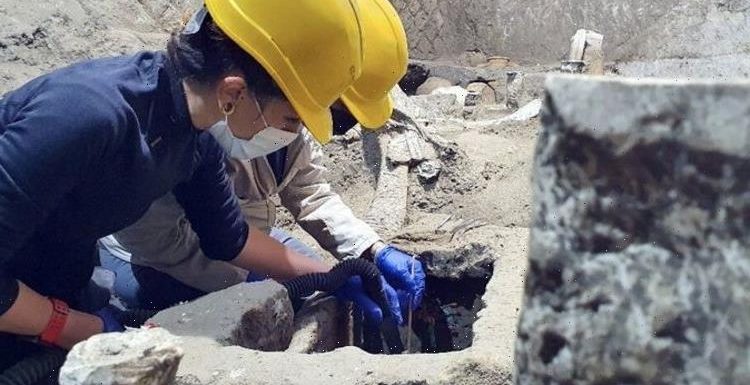
Pompeii: Expert discusses discovery of wall inscriptions
We use your sign-up to provide content in ways you’ve consented to and to improve our understanding of you. This may include adverts from us and 3rd parties based on our understanding. You can unsubscribe at any time. More info
The villa, which was destroyed 2,000 years ago by the eruption, had a small room with three beds, a ceramic pot and a wooden chest. The room was found during an excavation at the Villa of Civita Giuliana, a suburban villa just a few hundred metres from the rest of the ancient city. Researchers also found a nearly intact ornate Roman chariot earlier this year. But the archaeologists said that the room found in the most recent dig is likely to have housed slaves who were forced to maintain and prep that chariot.
The 16-square metre (170-square feet) room most likely functioned as both a bedroom for the slaves and a storeroom.
As well as three beds – one of which was child-sized – there were eight amphorae, stashed in a corner.
The wooden chest contained metal and fabric objects that appeared to be part of the harnesses of the chariot horses, and a chariot shaft was found resting on one of the beds.
The Pompeii Archaeological Park said: “The room grants us a rare insight into the daily reality of slaves, thanks to the exceptional state of preservation of the room.”
The remains of three horses were also found in a stable in a dig earlier this year.
Pompeii’s director-general Gabriel Zuchtriegel said: “This is a window into the precarious reality of people who rarely appear in historical sources, written almost exclusively by men belonging to the elite.”


He added that it is a “unique testimony” into how “the weakest in the ancient society lived.
Mr Zuchtriege was thrilled by the rare find.
He said: “It is certainly one of the most exciting discoveries in my life as an archaeologist.”
Pompeii was covered in ash when Mount Vesuvius erupted in 79 AD, killing thousands who couldn’t flee the city in time.
Most were crushed by collapsing buildings or killed by thermal shock.
Experts were able to make plaster casts of the beds and other objects in perishable materials which left their imprint in the cinerite, which is the rock made of volcanic ash that covered them after the eruption.

The beds were made of a few roughly worked wooden planks, which could be adjusted according to the height of the person who slept in them.
The webbed bases of the beds were made of rope, and covered by blankets.
Two of the beds were around 1.7 metres long, and one was only 1.4 metres, and is thought to have been a child’s bed.
The Archaeological Park thinks the three slaves might have all been one family.
Also unearthed were some personal objects under the beds, including amphorae (an ancient vase used to store things), ceramic jugs and what is thought to be a chamber pot.
DON’T MISS
End of the world: Earth to become unrecognisable [REVEAL]
Bermuda Triangle breakthrough as investigators uncover machine gun [INSIGHT]
Tsunami threat to UK ‘far more serious’ than scientists thought [REPORT]


The excavation is part of a programme launched in 2017 to try and combat illegal activity in the area.
Crimes involved tunnel digging to reach artefacts that can be sold on illicit markets.
The Villa of Civita Giulianain in particular was the target of systematic looting for many years.
There was evidence that some of the “archaeological heritage” in the room had also been stolen by thieves.
The Archaeological Park also said the grave robbers are thought to have caused about £1.7million.
Source: Read Full Article